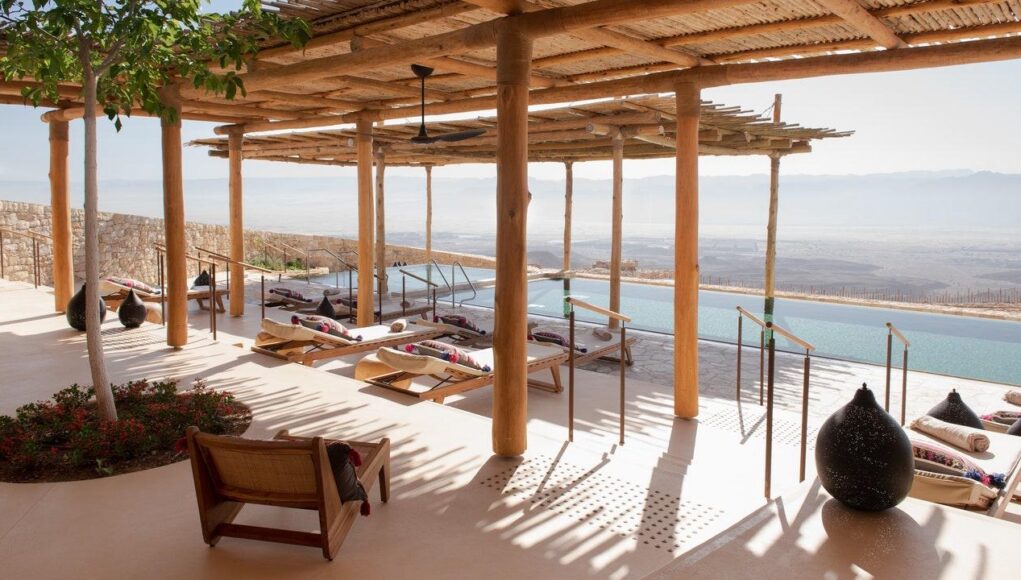Approaching Six Senses Shaharut, located off a dusty road in Israel’s Negev desert, the first thing you notice is almost nothing at all. The luxury brand’s newest boutique resort has an architectural language so in tune with its surroundings that its low, beige, stone structures, half-hidden above on rocky, sandy slopes, look as baked into the landscape as the ruins on the nearby Nabatean Spice Route. This nomadic spirit both bolsters and belies the meticulous design that unfolds, one focusing on both graceful, hidden spaces, and knock-out, 360-degree desert views.
Designed by family-run Tel Aviv-based Plesner Architects, the project, launched last August, took 10 years to conceive and build. Its sustainable construction emphasized local materials—most notably stone from nearby quarries—traditional techniques and preservation of the natural desert topography.
“We tried to leave the landscape as the main actor on the site,” says firm co-partner Daniela Plesner. “The goal was to make a place that feels as if it just had to be revealed, as if we moved the earth and found it existing there.”
The reveal begins after cars are left at the entrance “oasis” (think organic garden and date trees). Guests are transported up a steep road, past vast tracts of desert and snaking stone walls. Guest rooms seem to drop off into the hills. On the highest peak, where the public spaces are sited, the world opens up in astonishing ways, from the endless dome of sky to the expansive Arava Valley below to the granite Edom Mountains in the distance.
These public spaces include the Midian restaurant, Jamillah bar, a spa, yoga studio and gym. Made of stone and earthen-colored plaster, they unfold via secret-feeling stone passageways. (Much of the ground’s stonework was artfully hand laid by three local Arab families.) Terraces provide shade, and concrete latticework mashrabias, cast in a nearby kibbutz, are used throughout to improve air flow.
Inside, walls and floors are covered in Israeli plaster using a Moroccan surfacing technique called tadelakt, the many layers of which create the clean yet sumptuous look of a light, cream-colored leather. Fittings, textiles and artifacts are sourced worldwide—carpentry was made from recycled teakwood from India and Thailand, and other furniture, and fabrics, were imported from India, Thailand, Morocco, Turkey, Italy and more—but there’s a distinctive emphasis on Israeli-procured and handcrafted pieces. Framing for the brass furniture and steelwork, for instance, were made by a local artisan framer, and ceramic lighting fixtures, textiles and looms, serving utensils and dishes were crafted by local potters. The vibe: Tasteful, Bedouin-chic.
The 60 sunken guest rooms and villas are equally, subtly sumptuous. Organic linens and wool rugs tend toward neutral shades with subtle pops of color, and furniture, including the built-in beds and deep, slipcovered couches, seems to emerge from the floor. Better still, the glass walls and terraces (mostly with pools), built like outcroppings, make you feel as if you’re living outdoors.
“We wanted to enable a modern, luxurious hotel to blend into nature [without] making it feel cave-like,” Plesner explains of their biggest challenge. Mission accomplished.
Six additional new Israeli hotels worth checking out— and checking in.
Efendi Hotel, Acre
At the 12-room Efendi Hotel, nestled in the Old City of Acre, what’s old is new again. Composed of conjoined 19th-century Ottoman palaces—think ornamental ceilings with hand-painted motifs, and marble floors—the luxury hotel was restored by Israeli hotelier-restaurateur Uri Jeremias, archeologists and antiquities experts, and refreshed this year. Elegant rooms are a mix of antiques and plush modern furniture and fittings. Sip wine in its cozy, Byzantine-era cellar wine bar, and relax in the 400-year-old Turkish bath.
Debrah Brown, Tel Aviv
Little exemplifies a changing Tel Aviv better than the newly opened Debrah Brown hotel, a redesign of a 1964 luxury kosher hotel that, at 12 stories, was one of the tallest towers in a city now crowded with skyscrapers. The modernist building’s glamorous spin, complete with rooftop immersion pool, is from architect Prof. Yossi Friedman. The 89 guest rooms have a Great Gatsby opulence with lush emerald and gold velvets and brass fittings, perfect for a pre-dinner champagne.
Mitzpe Hayamim, Rosh Pina
Gaze out on a land of milk and honey from the Mitzpe Hayamim, a 37-acre, 95-room luxury spa and resort from hotel chain Isrotel overlooking the Sea of Galilee and green plateaus. Reopened in 2020 after a $23 million restoration by London-based design studio ARA and architects Yehuda and Yoel Feigin, the resort, where wellness is the watchword, features an expansive spa, organic farm, orchards and more. Interiors are a warm mix of light woods, natural fabrics and soothing colors.
Soho House Jaffa Tel Aviv
Nick Jones’ hotel and club chain added Israel to its growing footprint in August, choosing the historic Jaffa port district as its home. The castellated building, built in 1883 for a convent and featuring interiors from Soho House Design, Soho House’s in-house team, has 24 bedrooms with vaulted ceilings, timber parquet flooring and furniture inspired by the Bauhaus movement. Plus: courtyard garden, club spaces, and an art collection featuring Israeli artists. Israel just got a little more exclusive.
Galei Kinnerit, Sea of Galilee
Designed by Israeli interior design firm Saaar Zafrir Design and set directly on the shores of the legendary Sea of Galilee, Galei Kinnerit offers 123 sleekly-designed rooms inspired by Italy’s legendary Villa d’Este Hotel. The property inhabits an existing hotel from the 1940s which has been given elegant new life and features luxe suites with private jacuzzis, a Galilee-front swimming pool, private beach and boat access and a neo-Levantine aesthetic crafted from regional woods, stones and marble.








